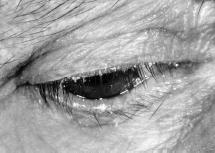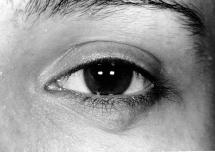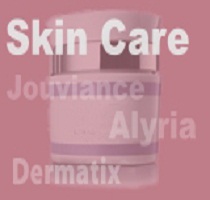Volume 1 • Issue 2
Blepharitis, Styes and Chalazions

by David R. Jordan
M.D., F.A.C.S., F.R.C.S.(C)
INTRODUCTION
What is blepharitis?
Blepharitis refers to inflammation of the eyelid margin. It is common and may cause symptoms such as irritation, itching and red eyes. This condition frequently occurs in people who have oily skin, dandruff or dry eyes. It can begin early in childhood and continue throughout life as a chronic condition, or develop later in life.
Bacteria reside on the surface of everyone’s skin but, in certain individuals, they thrive in the skin at the base of the eyelashes. The resulting irritation, sometimes associated with over activity of the nearby oil glands, causes dandruff-like scales and particles of discharge to form along the lashes and eyelid margins (Figure 1). For some people, the discharge associated with blepharitis produces only minor irritation and itching but, in others, it may cause redness, stinging or burning. Some people may develop an allergy to the scales or to the bacteria which surrounds them. This can occasionally lead to more serious inflammation of the eye, particularly the cornea.


Figure 1 “blepharitis with discharge built up along eyelash roots” (top and bottom).
How is blepharitis treated?
Blepharitis can be a persistent problem. Although there is no specific cure, it can usually be controlled through eyelid hygiene.
1) Have the patient use a clean wash cloth, wet it with hot tap-water, wring it out and place it over the closed eyelids for 5 minutes. This will help soften the crusts and loosen the oily debris. Re-wet as necessary to maintain the desired temperature.
2) A 50:50 mixture of warm water and Johnson’s (no tears) baby shampoo is then prepared in a small glass. The patient should look into a mirror and, using a Q-tip dipped into this solution, the eyelid margin where the lash follicles are located, is gently brushed. If Q-tips are difficult to use, cotton balls or even the warm wet face cloth may be tried. There are commercial preparations available such as “Lid Care” (by CIBA) which can be used to clean the lid rather than the Johnson’s mixtures described. These may be easier for some individuals but are more costly.
3) The eyelids are then gently rinsed with warm water. Discard any cleaning solution left over.
4) In moderate or resistant cases, a topical ointment may be applied after the lid cleansing at bedtime.
Topical Erythromycin (Ilotycin), Polysporin or Bacitracin ointment are the best to use. What about steroid containing ointments? While antibiotic-steroid medications often hasten relief of symptoms, long term use can cause harmful side effects such as glaucoma. Thus, if they are to be used, the patient should be seen by an Ophthalmologist.
Long term maintenance?
The eyelid hygiene routine is initially done once or twice daily and up to four times per day in severe cases. Once the acute phase of the condition is overcome, a process which may take several weeks, the blepharitis usually comes under control and the patient can handle it with the eyelid hygiene routine on a less frequent basis, ex. just at night or perhaps once or twice weekly will do.
Blepharitis does tend to wax and wane and thus, the lid hygiene may be required more frequently at some times.
What is a stye (also known as a hordeolum)?
An acute infection involving the oil glands of the lid (meibomian glands) or of the sweat and sebaceous glands around the lash follicles form a red tender lump near or at the eyelid margin referred to as a “stye” (Figure 2). Patients with blepharitis commonly develop styes at some point in their life.
How is a stye treated?
In the acute phase, the most important treatment is a tap-water hot face cloth applied to the involved lid 5 to 10 minutes at a time 3 to 4 times a day. This helps to dilate the gland and draw out the discharge. In addition, a broad spectrum antibiotic eye drop such as Sulfacetamide or Polysporin is helpful four times daily with a similar ointment at night. If there is a lot of eyelid cellulitis, an oral antibiotic such as Cloxicillin or Erythromycin will help settle it down over 5 to 7 days. Most styes resolve with this treatment. If they persist beyond six weeks, they usually do not resolve on their own and form a chalazion.
What is a chalazion? (Pronounced kah-la-ze-on)
The term chalazion refers to a swelling in the eyelid caused by chronic inflammation of one of the oil glands (meibomian glands) within the tarsal plate. They usually sit as quiet lumps within the eyelid and may intermittently swell and become inflamed (Figure 2). They can press on the eyeball causing visual blurring.


Figure 2 “acute hordeolum involving lower lid (top)
and a chronic chalazion presenting as a lump within
the lower lid (bottom)”
How are chalazions treated?
If the patient arrives with a chalazion, present for 6 weeks and there is associated inflammation, it may be treated as a stye, i.e. using antibiotic eye drops, ointment and hot compresses. If there is associated blepharitis, the blepharitis routine may be tried as well (i.e. eyelid cleansing routine).
It is not uncommon for the patient to present with a quiet chalazion just sitting within the eyelid for the past several months. These usually do not respond to the above routine but it will not do any harm to try for 1 to 2 weeks.
A chalazion as well as a stye should not be manually squeezed as a very “acute eyelid cellulitis” may be precipitated.
If the chalazion is quiet and been there for at least 6 weeks and the patient has used the antibiotic, hot compress routine, they rarely resolve on their own. Surgical incision is the next step. This is a simple out-patient procedure done under local anesthesia in a minor surgical procedure room. Local anesthetic is placed into the lid around the lump. A small incision is then made on the inside of the lid to drain the chalazion. Antibiotic eye drops are used for 1 week following this procedure. The patient can return to work later in the day or the following day.
Chalazions usually respond well to surgical incision although some people are prone to recurrences. If a chalazion recurs in the same place in an aging individual, a biopsy is usually obtained to rule out the possibility of sebaceous cell adenocarcinoma, a rare malignancy arising within the sebaceous glands of the eyelid.
If you have any questions regarding the topics of this newsletter, or requests for future topics of InSight, please contact Dr. David R. Jordan office by telephone at (613) 563-3800.







